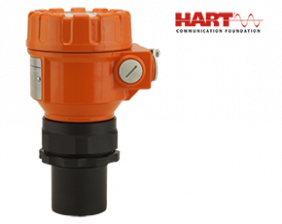KOBOLD Instruments Inc • 1801 Parkway View Drive • 15205 Pittsburgh, PA • Tel: +1 412 788 2830 • E-mail: info@koboldusa.com • visit koboldusa.com

Ultrasonic Level Meter NUS-4
Measuring range: liquids up to 25 m, solids up to 10 m
Connection: G 1½ , G2, 1½" NPT, 2" NPT male thread,
flange DN80, 125, 150, ANSI 3",5",6"
Material connection: PP, PVDF
pmax: 3 bar abs.
tmax: 90°C
Accuracy: ±0.2 % of reading ±0.05 % of full scale
Power supply: 12 - 36 VDC, 2-wire
Output: 4 - 20 mA, relay
LCD-indication and programming unit

Datasheet
Operating Instructions
Miscellaneous
Downloads
Driver for HARTCOMM modem
Description
The Kobold ultrasonic level meter, model NUS-4, is used for non-contact, continuous level and volume measurement in vessels or for flow measurement in open channels. Level measurement technology based on the non-contacting ultrasonic principle is especially suited for applications where, for any reason, no physical contact can be established to the surface of the material to be measured.
Such reasons may include corrosive attack by the process medium against the measuring device material (acids), possible contamination (sewage) or particles of the process medium adhering to the measuring device (adhesive materials).The ultrasonic level metering technology is based on the principle of measuring the time required for the ultrasound pulses to make a round trip from the sensor to the level to be measured and back.
The sensor emits an ultrasonic pulse train and receives the echoes reflected. The electronic evaluates the echo time of the pulses and determines the level. The evaluating electronics is mounted compact on the unit. For remote transmission, a norm signal output and for monitoring purposes, a relay contact is available. For programming and for local display, the units may be delivered with an optional pluggable programming unit with LCD display.
The sensors have a total beam angle of 5° - 7° at -3 dB. This ensures a reliable measurement in narrow silos with uneven side walls as well as in process tanks with various protruding objects. Furthermore, as a result of the narrow beam angle - the emitted ultrasonic signals have an outstanding focusing - deep penetration through gases, vapour and foam is ensured.






